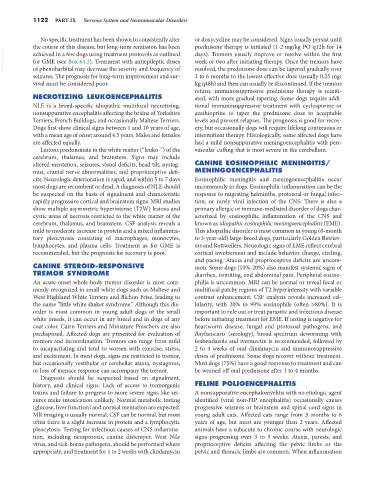Page 1150 - Small Animal Internal Medicine, 6th Edition
P. 1150
1122 PART IX Nervous System and Neuromuscular Disorders
No specific treatment has been shown to consistently alter or doxycycline may be considered. Signs usually persist until
the course of this disease, but long-term remission has been prednisone therapy is initiated (1-2 mg/kg PO q12h for 14
VetBooks.ir achieved in a few dogs using treatment protocols as outlined days). Tremors usually improve or resolve within the first
week or two after initiating therapy. Once the tremors have
for GME (see Box 64.3). Treatment with antiepileptic doses
of phenobarbital may decrease the severity and frequency of
3 to 6 months to the lowest effective dose (usually 0.25 mg/
seizures. The prognosis for long-term improvement and sur- resolved, the prednisone dose can be tapered gradually over
vival must be considered poor. kg q48h) and then can usually be discontinued. If the tremors
return, immunosuppressive prednisone therapy is reiniti-
NECROTIZING LEUKOENCEPHALITIS ated, with more gradual tapering. Some dogs require addi-
NLE is a breed-specific idiopathic multifocal necrotizing, tional immunosuppressive treatment with cyclosporine or
nonsuppurative encephalitis affecting the brains of Yorkshire azathioprine to taper the prednisone dose to acceptable
Terriers, French Bulldogs, and occasionally Maltese Terriers. levels and prevent relapses. The prognosis is good for recov-
Dogs first show clinical signs between 1 and 10 years of age, ery, but occasionally dogs will require lifelong continuous or
with a mean age of onset around 4.5 years. Males and females intermittent therapy. Histologically, some affected dogs have
are affected equally. had a mild nonsuppurative meningoencephalitis with peri-
Lesions predominate in the white matter (“leuko-”) of the vascular cuffing that is most severe in the cerebellum.
cerebrum, thalamus, and brainstem. Signs may include
altered mentation, seizures, visual deficits, head tilt, nystag- CANINE EOSINOPHILIC MENINGITIS/
mus, cranial nerve abnormalities, and proprioceptive defi- MENINGOENCEPHALITIS
cits. Neurologic deterioration is rapid, and within 5 to 7 days Eosinophilic meningitis and meningoencephalitis occur
most dogs are recumbent or dead. A diagnosis of NLE should uncommonly in dogs. Eosinophilic inflammation can be the
be suspected on the basis of signalment and characteristic response to migrating helminths, protozoal or fungal infec-
rapidly progressive cortical and brainstem signs. MRI studies tion, or rarely viral infection of the CNS. There is also a
show multiple asymmetric hyperintense (T2W) lesions and primary allergic or immune-mediated disorder of dogs char-
cystic areas of necrosis restricted to the white matter of the acterized by eosinophilic inflammation of the CNS and
cerebrum, thalamus, and brainstem. CSF analysis reveals a known as idiopathic eosinophilic meningoencephalitis (EME).
mild to moderate increase in protein and a mixed inflamma- This idiopathic disorder is most common in young (8-month
tory pleocytosis consisting of macrophages, monocytes, to 3-year-old) large-breed dogs, particularly Golden Retriev-
lymphocytes, and plasma cells. Treatment as for GME is ers and Rottweilers. Neurologic signs of EME reflect cerebral
recommended, but the prognosis for recovery is poor. cortical involvement and include behavior change, circling,
and pacing. Ataxia and proprioceptive deficits are uncom-
CANINE STEROID-RESPONSIVE mon. Some dogs (10%-20%) also manifest systemic signs of
TREMOR SYNDROME diarrhea, vomiting, and abdominal pain. Peripheral eosino-
An acute-onset whole-body tremor disorder is most com- philia is uncommon. MRI can be normal or reveal focal or
monly recognized in small white dogs such as Maltese and multifocal patchy regions of T2 hyperintensity with variable
West Highland White Terriers and Bichon Frise, leading to contrast enhancement. CSF analysis reveals increased cel-
the name “little white shaker syndrome.” Although this dis- lularity, with 20% to 99% eosinophils (often >80%). It is
order is most common in young adult dogs of the small important to rule out or treat parasitic and infectious disease
white breeds, it can occur in any breed and in dogs of any before initiating treatment for EME. If testing is negative for
coat color. Cairn Terriers and Miniature Pinschers are also heartworm disease, fungal and protozoal pathogens, and
predisposed. Affected dogs are presented for evaluation of Baylisascaris (serology), broad-spectrum deworming with
tremors and incoordination. Tremors can range from mild fenbendazole and ivermectin is recommended, followed by
to incapacitating and tend to worsen with exercise, stress, 2 to 4 weeks of oral clindamycin and immunosuppressive
and excitement. In most dogs, signs are restricted to tremor, doses of prednisone. Some dogs recover without treatment.
but occasionally vestibular or cerebellar ataxia, nystagmus, Most dogs (75%) have a good response to treatment and can
or loss of menace response can accompany the tremor. be weaned off oral prednisone after 3 to 4 months.
Diagnosis should be suspected based on signalment,
history, and clinical signs. Lack of access to tremorgenic FELINE POLIOENCEPHALITIS
toxins and failure to progress to more severe signs like sei- A nonsuppurative encephalomyelitis with no etiologic agent
zures make intoxication unlikely. Normal metabolic testing identified (viral non-FIP encephalitis) occasionally causes
(glucose, liver function) and normal mentation are expected. progressive seizures or brainstem and spinal cord signs in
MR imaging is usually normal. CSF can be normal, but most young adult cats. Affected cats range from 3 months to 6
often there is a slight increase in protein and a lymphocytic years of age, but most are younger than 2 years. Affected
pleocytosis. Testing for infectious causes of CNS inflamma- animals have a subacute to chronic course with neurologic
tion, including neosporosis, canine distemper, West Nile signs progressing over 3 to 5 weeks. Ataxia, paresis, and
virus, and tick-borne pathogens, should be performed where proprioceptive deficits affecting the pelvic limbs or the
appropriate, and treatment for 1 to 2 weeks with clindamycin pelvic and thoracic limbs are common. When inflammation

